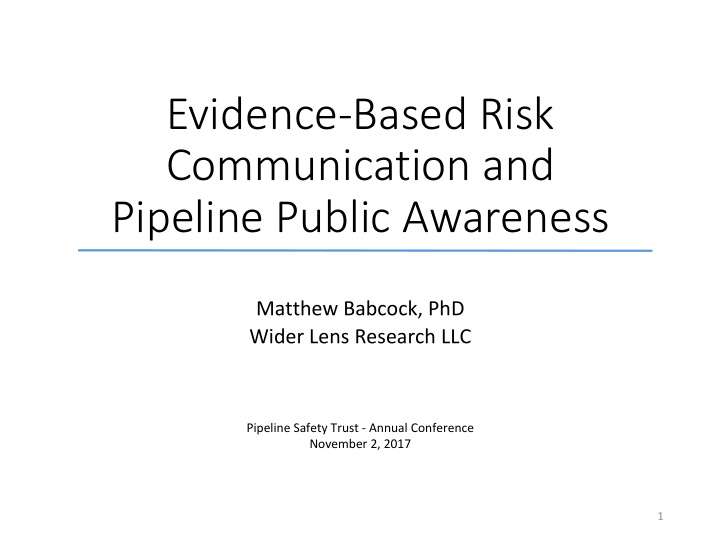



Evidence-Based Risk Communication and Pipeline Public Awareness Matthew Babcock, PhD Wider Lens Research LLC Pipeline Safety Trust - Annual Conference November 2, 2017 1
Today’s Presentation 1. Challenges and importance of successful risk communication 2. Evidence-based design and evaluation of risk communication 3. Initial recommendations related to RP 1162 2
Perceptions of risks and contexts differ Source: Parfomak, P.W. (2016). DOT’s federal pipeline safety program 3
mplex systems à more groups, Comp wider differences in perceptions of risk “Public awareness of where pipelines are located and an understanding of the safety concerns and risks associated with pipeline transmission are vital to the continued safe operation of pipelines” - PHMSA PAPWG Report 2016 https://www.phmsa.dot.gov/safety-awareness/pipeline/safety-awareness-overview 4
Risk communications can have dif different t goals als Type of Example Pipeline Safety Description Communication Communication Emergency situation Evacuation announcements 1. Crisis Inducing action Requires action right away related to a pipeline failure Advisory notices regarding One- Agreement on risk 2. Care Call Systems/811/”Call-Before- Agreement on what to do about risk You-Dig” Informing Advising communities on the Less agreement on risk decision “benefits of pipelines and the 3. Consensus Less agreement on what to do about making risks associated with pipeline risk failures” 5 Adapted from Lundgren, R. E., & McMakin, A. H. (2015). Risk Communication: A handbook for communicating environmental, safety, and health risks.
Another wrinkle: we assume me we are better at communicating than we are Why? • Common knowledge effect à assume others have the similar understanding as us • False consensus effect à assume others will make the same decision as us • Other biases and myths 6
Summary of challenges Different individuals/contexts Inefficient strategies Misinformed or under- Increased complexity informed audience Confusion of goals Mistrust, acrimony, breakdown in Tendency to use faulty communication intuition 7
Hard to do in complex contexts à need evidence-based strategies Assume only one Audience ↓ “Know”/Assume your Audiences ↓ Listen to, Work with, and Know your Audiences 8
Hard to do in complex context à need evidence-based strategies 9
Au Audien ence-F ce-Focu ocused ed D Des esign of Risk Communications 1. Analyze information people need to know 2. Assess what they currently believe 3. Address the gaps between 1 and 2 10 Adapted from FDA Communicating risks and benefits: An evidence based user's guide and de Bruin and Bostrom (2013).
Men Mental Mo al Models A dels Appr pproac ach h Expert “Lay”/Expert External External Driver Driver Interaction Interaction External External Driver Driver Interaction Interaction Perception Perception Perception Perception Interaction Decision Perception Interaction Decision Perception External Driver Outcome Outcome 11
Requireme ments for Successful Risk Communications 1. The communication contains the information needed for effective decision making. 2. The communication connects users to that information. 3. The communication is understood by users. 12 Adapted from FDA Communicating risks and benefits: An evidence based user's guide .
some evidence -----------> more evidence No/Low Expense Moderate Expense Substantial Expense Ask friends, family, coworkers, and staff to review and say what they think. Strategies from No/Low Expense category plus: “Think-Aloud” process with convenience sample focused on Strategies from Moderate One-on-one structured opinions on: Expense category plus: interviews - comprehension - completeness Randomized control experiments Transcript/text analysis of -bias interviews and focus groups Surveys with representative Ask internal experts to review samples and pre/post testing Some survey approaches communication Search of less available data Some focus groups Search of public data Adapted from FDA Communicating risks and benefits: An evidence based user's guide . 13
Summary of research guidance • Evidence-based design and evaluation • Includes and requires more interaction with audiences • Resources upfront + understanding audience context à efficiency, effectiveness, trust 14
Initial Recommendations re: RP 1162 Stakeholders/Participation Involve additional experts and public stakeholders in development of future guidance à close gap between groups Goals Clarify when the goal of the public awareness program is to improve decision making and when is the goal to induce behaviors 15
Initial Recommendations re: RP 1162 Design of Risk Communications • Emphasize understanding audience as first step and clarify enhanced/baseline Evaluation of Risk Communications • Emphasize effectiveness in addition to implementation API RP 1162 (2 nd ed.) 16
Thank you. References: Dawes RM, Mulford M (1996) The false consensus effect and overconfidence. Organ Behav Hum Decis Process 65(3): • 201–211. de Bruin, W. B., & Bostrom, A. (2013). Assessing what to address in science communication. Proceedings of the National • Academy of Sciences , 110 (Supplement 3), 14062-14068. Fischhoff B, Brewer NT, Downs JS (2011). Communicating risks and benefits: An evidence based user's guide . • Government Printing Office. Fischhoff, B. (1995). Risk perception and communication unplugged: twenty years of process. Risk analysis , 15 (2), • 137-145. Lundgren, R. E., & McMakin, A. H. (2015). Risk Communication: A handbook for communicating environmental, safety, • and health risks. Morgan, G. (2017). Theory and Practice in Policy Analysis . Cambridge University Press. • Morgan, M. G. (2002). Risk communication: A mental models approach . Cambridge University Press. • National Research Council. (2008). Public participation in environmental assessment and decision making . National • Academies Press. National Research Council. (1996). Understanding risk: Informing decisions in a democratic society . National Academies • Press. Nickerson RA (1999) How we know – and sometimes misjudge – what others know. Psychol Bull 125(6):737–759. • Slovic, P., Fischhoff, B., & Lichtenstein, S. (1980). Facts and fears: Understanding perceived risk. Societal risk assessment: • How safe is safe enough , 4 , 181-214. 17
Original Risk Communication Strategy “All we have to do is get the numbers right” and “All we have to do is tell them the numbers” (Probability of an Event) x (Magnitude of Harm) = Expected Outcome If the Expected Outcome is worse for Option A, go with Option B. 18
Recommend
More recommend